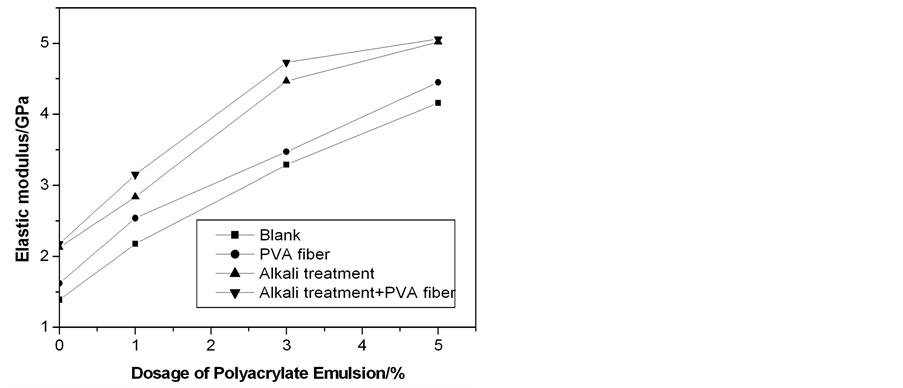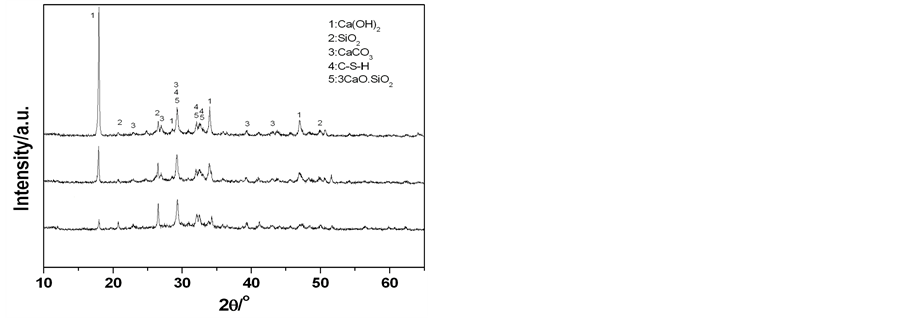1. 引言
随着经济快速发展以及人民生活质量提高,自上世纪90年代以来,人们开始追求绿色建筑材料。绿色建筑材料具有无毒无味、高强、安全、吸声隔音、耐水防火、轻质以及保温节能等优点[1] 。其中植物纤维-水泥复合材料就具备上述优点。我国是一个农业大国,农作物秸秆资源十分充足。将植物纤维应用在建筑复合材料中既合理利用资源,又保护了环境,能提高其使用价值。植物纤维水泥-复合材料的应用已得到许多学者的重视[2] -[6] 。但是植物纤维对水泥有阻凝作用,与水泥界面相容性较差,经过处理能提高植物纤维与水泥的相容性[7] [8] 。通过碱处理后能减少植物纤维中的阻凝成分,有效地改善植物纤维与水泥结合的界面,同时复合材料的力学性能得到提高[9] 。作为一种亲水性纤维,聚乙烯醇(PVA)纤维容易与水泥基复合材料界面粘结性好;其结构式中具有与水泥水化产物中羟基结合形成氢键的-C-OH基团。其分子链上的-C-OH基团可与水泥水化产物中的羟基形成氢键结合,聚乙烯醇纤维的非圆形截面和分子结构特点是提高其与水泥基体界面黏结的有利条件[10] 。聚丙烯酸酯乳液(Polyacrylate emulsion)具有分子量大、干燥成膜快、对于多种基材粘接性能好、透明度高、耐候耐水性好和无污染等优点,有利于提高水泥砂浆的强度[11] 。本文利用聚丙烯酸酯乳液对稻壳-水泥复合材料进行改性,然后进行力学性能测试,用FT-IR, XRD, SEM对其进行表征,并对其改性机理进行分析。
2. 材料与方法
2.1. 原料及实验仪器
哈尔滨本地的稻壳;P.O42.5R早强型普通硅酸盐水泥(天鹅牌);山东日照广大化工有限公司生产的聚丙烯酸酯乳液(指标见表1);Na2SiO3;山东泰安同伴纤维有限公司生产的PVA纤维(性能指标见表2)。
2.2. 稻壳–水泥复合材料的制备
设定复合材料的密度为1200 kg/m3。首先将粉碎后的稻壳(小于5 mm)投入搅拌机中,同时将作用于稻壳的聚丙烯酸酯乳液配置成一定浓度的水溶液(水灰比为1:3,配置各种助剂溶液的水量总和即为此工艺条件下的需水量),在搅拌的过程中,利用喷雾器均匀喷洒在稻壳表面,然后将水泥投入到搅拌机中与稻壳混合搅拌,至各原料搅拌均匀即可。铺装成型后,在2.5 MPa压力下冷压成420 mm × 400 mm × 15 mm的材料,并保压72 h。在室温下自然养生28 d (定期向复合材料喷水),切割进行力学性能测试及样品表征。实验中样品编号1~8原料含量见表3所示,样品编号9~16号原料含量分别对应上表1~8号的原料含量,但用5%硅酸钠溶液处理;5% Na2SiO3溶液处理为稻壳浸泡在5% Na2SiO3溶液中24 h后,然后用冷水冲洗直至将残留在稻壳中的处理液及水溶性生成物完全除去,最后烘干。
2.3. 稻壳–水泥复合材料性能测试
稻壳–水泥复合材料静曲强度、弹性模量、密度按照水泥木屑板JC411/T-2007标准测试;将稻壳–水泥复合材料泡在无水乙醇中,机械破坏后研磨成粉末,干燥后在室温下在日本理学D/MAX 2200 VPC上进行测定(扫描速度4˚/min,扫描范围10˚~70˚);将稻壳–水泥复合材料泡在无水乙醇中,机械破坏后研磨成粉末,干燥后,用KBr压片制样,在Nicolet MAGNA-IR560型上进行测定,扫描范围400 cm−1~4000 cm−1;稻壳–水泥复合材料用机械破坏后,选取无机械印记的试样,喷金后在QUANTA200型下进行微观形貌观察。
3. 结果与讨论
3.1. 力学性能分析
图1和图2分别为不同条件下复合材料的抗折强度和弹性模量。由图1和图2可以看出,随着聚丙
表1. 聚丙烯酸酯乳液的主要指标

Table 2. Performance index of PVA fiber
表2. PVA纤维的性能指标

Table 3. The content of rice husk-cement composites
表3. 稻壳–水泥复合材料的原料含量

Figure 1. The effect of dosage of PAE on the composites of Flexural Strength
图1. PAE掺量对复合材料抗折强度的影响

Figure 2. The effect of dosage of PAE on the composites of Elastic Modulus
图2. PAE掺量对复合材料弹性模量的影响
烯酸酯乳液掺量的增加,复合材料的力学性能逐渐增加,0%~3%之间力学性能得到了明显改善,抗折强度从1.93 MPa增长到6.72 MPa,弹性模量从1.39 GPa增长到4.73 GPa;3%~5%之间力学性能有所增加,增长幅度不大,抗折强度从6.72 MPa增长到7.02 MPa,弹性模量从4.73 GPa增长到5.06 GPa。聚丙烯酸酯乳液的加入可以改变水泥的结构。作为一种多相非均质结构,水泥中存在大量的凝胶孔、毛细孔和大空隙。聚丙烯酸酯乳液颗粒很小,平均粒径只有100 nm左右,加入到水泥基复合材料中,能填充空隙达到降低空隙率的目的。聚合物成膜后,长链高分子能更好地把稻壳和水泥胶结在一起,同时其本身的柔韧性,赋予复合材料很好的韧性,故复合材料的力学性能得以提高。
水泥水化的pH在12左右,而稻壳中含有许多糖类物质,这些糖类物质不利于水泥的水化,甚至引起水泥不凝[12] 。用5%的硅酸钠处理稻壳后,稻壳表面的蜡质层发生水解,破坏了其堡垒作用,使稻壳表面变得粗糙不平,出现一些沟槽,有利于胶钉作用形成,大大提高了复合材料的力学性能。
加入PVA纤维后复合材料力学性能没有显著性增强,可能是因为PVA纤维在水泥基体中具有成团倾向,分散性不好,没有起到增强纤维的增强效果;PVA纤维含有许多羟基,与水泥基材料粘结力强,能一定程度地控制水泥基体中的裂缝,改善水泥基体的微观结构,力学性能还是有一定的增强效果。
3.2. FT-IR分析
图3为7、11和16号稻壳-水泥复合材料的FT-IR谱图。在470 cm−1和870 cm−1处的吸收峰可能分别是Si-O和Al-O伸缩振动的硅酸盐和铝酸盐组。在1634 cm−1和3434 cm−1处有强烈的吸收峰与Ca(OH)2的形成有关。随着工艺条件的改变,与Ca(OH)2形成有关的H2O和OH的伸缩振动峰不断增强。由于在C-S-H凝胶的形成过程中 聚合度的变化,Si-O键的不对称收缩从940 cm−1向高波数1033 cm−1发生迁移。早期由于钙矾石的形成,在1100 cm−1出现酯类C=O键的吸收峰,说明在聚合物中存在丙烯酸酯类的特征吸收峰。碳酸盐的特征振动峰分别在1465 cm−1和870 cm−1出现。在870 cm−1的吸收峰与C2S和C2S相和ν2(CO3)是一致的。这可能是因为金属羧酸盐在水泥中的混合物的形成。在1465 cm−1和1100 cm−1处的吸收峰与水泥中的C-S-H存在相关。在1635 cm−1和3445 cm−1处的吸收峰是由于水泥中硫酸钙以钙矾石的形式存在。在1421 cm−1处的吸收峰表明碳酸根的存在。其它水化产物形成相关的基团的特征振动峰没有明显变化。
聚合度的变化,Si-O键的不对称收缩从940 cm−1向高波数1033 cm−1发生迁移。早期由于钙矾石的形成,在1100 cm−1出现酯类C=O键的吸收峰,说明在聚合物中存在丙烯酸酯类的特征吸收峰。碳酸盐的特征振动峰分别在1465 cm−1和870 cm−1出现。在870 cm−1的吸收峰与C2S和C2S相和ν2(CO3)是一致的。这可能是因为金属羧酸盐在水泥中的混合物的形成。在1465 cm−1和1100 cm−1处的吸收峰与水泥中的C-S-H存在相关。在1635 cm−1和3445 cm−1处的吸收峰是由于水泥中硫酸钙以钙矾石的形式存在。在1421 cm−1处的吸收峰表明碳酸根的存在。其它水化产物形成相关的基团的特征振动峰没有明显变化。
3.3. XRD分析
图4为7、11和16号稻壳–水泥复合材料的XRD谱图。预期的水化产物在图中可以明显看到。随着工艺条件的改变,水化产物XRD衍射峰强度改变。通过硅酸钠处理后,Ca(OH)2的衍射峰强度增强,它能很好促进水泥的水化;加入PVA纤维后,Ca(OH)2的衍射峰强度减弱,PVA纤维能与Ca2+相结合,减少Ca(OH)2的量。另外有一定量的碳酸钙生成可能是因为Ca(OH)2的碳化造成的。 在C3S相中,其衍射峰与碳酸钙的衍射峰相重叠;但是经过碱处理和加入PVA纤维后,C3S的衍射峰强度有所降低。二氧化硅的衍射峰可能有部分来自稻壳。聚丙烯酸酯乳液掺加到稻壳-水泥复合材料中,没有新的物质生成。
3.4. SEM分析
图5(a)为不做任何处理的扫描电镜图片。复合材料有缝隙存在,二者结合不是很好。图5(b)为加入体积掺量为0.6 kg/m3的PVA纤维的扫描电镜照片,PVA纤维附着在水泥基体中,起到了一定的增强作

Figure 3. The infrared spectra of rice husk-cement composites
图3. 稻壳–水泥复合材料的红外光谱图

Figure 4. XRD patterns of rice husk-cement composites
图4. 稻壳–水泥复合材料的XRD谱图

Figure 5. SEM micrographs of rice husk-cement composites
图5. 稻壳–水泥复合材料的扫描电镜照片
用。图5(c)为稻壳用硅酸钠处理后的图片,可明显观察到稻壳被水泥完全包埋,结合得比较紧密,角质层最外面的蜡质层发生水解,破坏了角质层的堡垒作用,使稻壳表面变得粗糙不平,出现一些沟槽,有利于胶钉作用形成,提高了水泥复合材料性能。图5(d)为硅酸钠处理后并加入PVA纤维的图片,聚丙烯酸酯乳液在水泥基体中形成网状结构,该网状结构有效地控制裂缝,改善了稻壳和水泥的结合状况,复合材料性能得到提高。
4. 结论
聚丙烯酸酯乳液能填充在水泥复合材料的空隙中,并降低其收缩率,能在复合材料中形成网状结构,提高其力学性能。用5%硅酸钠溶液处理稻壳后,角质层最外面的蜡质层发生水解,破坏了角质层的堡垒作用,使稻壳表面变得粗糙不平,出现一些沟槽,有利于胶钉作用形成,所以复合材料的力学性能得到大幅度提高;PVA纤维具有成团倾向,在水泥基体中分散性不好,没有充分发挥其增强效果。
致谢
感谢黑龙江省交通运输厅科技项目基金(2012-43)对本文的资助。